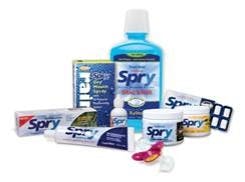“Hey Kids, Xylitol five times a day keeps cavities away!”Wouldn’t that be a miracle? And it is! Xylitol is the miracle natural sweetener with the capacity to help rid those nasty bugs that cause caries and sticky plaque when used five times a day! And the best part is that is tastes great … just like sugar! Xylitol is a natural sweetener that comes from the fibers in plants such as fruits, vegetables and corn cobs. We consume about 8-10 grams daily in our diet and humans naturally formulate xylitol in the liver and it is essential in the conversion of food to energy. The beauty of Xylitol is that it consists of a 5 carbon chain. Bacteria cannot digest a 5 carbon chain. Xylitol tricks the bacteria into thinking it is a food source and ingests the sweetener but cannot digest it, therefore it cannot produce sticky polysaccharides that allow bacteria to stick to one another, the teeth or tissues. The affected bacteria break away from the existing biofilm reducing the plaque and harmful Strep Mutans.
Studies show that Xylitol:• When used by mothers, prohibits the transmission of Strep Mutans from mother to child• Strengthens newly erupted teeth as well as those exposed to dry mouth or high acidic food• When discontinued, has lasting caries reduction effects for 2-3 years.• Increases saliva, raises PH, and enhances remineralization• Reduces damage to teeth while wearing fixed orthodontics• Gum chewing reduces the occurrence of otitis media by 40%Instead of viewing ages 5-12 as the cavity prone years, we can now see this time period as the best opportunity to offer xylitol to strengthen teeth for life! The recommended exposure protocol for xylitol is 5-8 times a day with a total of 8-10 grams per day … Strive for Five! Xylitol products vary and reading labels is important. For example, if the label on the product lists other sweeteners such as sorbitol, which is a 6 carbon chain, then xylitol will be less effective. Make sure that xylitol is the first ingredient and that there are no other sweeteners on the label.
H. Olsson, C. J. Spak, T. Axell, “The effect of a chewing gum on salivary secretion, oral mucosal friction and the feeling of dry mouth in xerostomic patients,” Acta Odontologica Scandinavia vol. 49, pp. 273-279, 1991.P. P. Hujoel, K. K. Mäkinen, C. A. Bennett, et al., “The optimum time to initiate habitual xylitol gum-chewing for obtaining long-term caries prevention,” Journal of Dental Research, vol. 78, no. 3, pp. 797–803, 1999.P. Isokangas, E. Söderling, K. Pienihäkkinen, P. Alanen, “Occurrence of dental decay in children children after maternal consumption of xylitol chewing gum, a follow-up from 0 to 5 years of age,” Journal of Dental Research, vol. 79, no. 11, pp. 1885-1889, Nov. 2000.S. E. Coldwell, T. K. Oswald, D. R. Reed, “A marker of growth differs between adolescents with high vs. low sugar preference,” Behavior Physiology vol. 96, no. 23, pp. 574-580, March, 2009.K. P. Isotupa, S. Gunn, C. Y. Chen, D. Lopatin, K. K. Mäkinen, “Effect of polyol gums on dental plaque in orthodontic patients,” American Journal of Orthodontics and Dentalfacial Orthopedics vol. 107, pp. 497-504, 1995.Y. Miake, M. Takahashi, Y. Saeki, T. Yanagisawa, “Effect of xylitol on remineralization of demineralized enamel,” The Shikwa Gakuho, vol. 99, pp. 393-399, 1999 (Japanese).T. Yanagisawa, Y. Miake, “Prevention of caries and restoration of initial enamel caries by remineralization enhanced with xylitol +2 gum,” Finnish Dental Journal, vol. 13, supplement 1, pp. 44-49, 2006.M. Brin, O. N. Miller, “The safety of oral xylitol,” in: “Sugars in Nutrition” (H. L. Sipple, K. W. McNutt, eds), pp. 591-605, Academic Press, New York 1974.H. K. Åkerblom, T. Koivukangas, et al, “The tolerance of increasing amounts of dietary xylitol in children,” International Journal of Vitamin and Nutrition Research vol. 22 (supplement), pp. 53-66, 1982.M. Uhari, T. Kontiokari, M. Koskela, M. Niemelä, “Xylitol chewing gum in prevention of acute otitis media: double blind randomised trial. British Medical Journal vol. 313, no. 7066, pp. 1180-1184, 1996.









